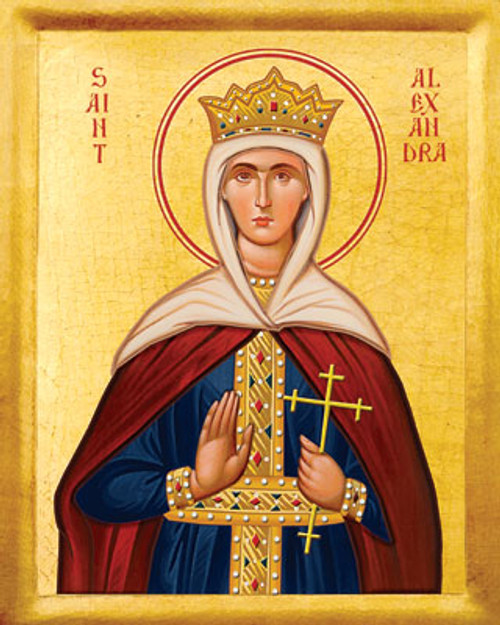Commemorated on December 1
Eligius was born at the villa of Captelat, six miles north of Limoges, in Aquitaine (now France), into an educated and influential Gallo-Roman family. His father, recognising unusual talent in his son, sent him to the goldsmith Abbo, master of the mint at Limoges. Later Eligius went to Neustria, the palace of the Franks, where he worked under Babo, the royal treasurer, on whose recommendation Clotaire II, king of the Franks, is said to have commissioned him to make a throne of gold adorned with precious stones.
"And from that which he had taken for a single piece of work, he was able to make two. Incredibly, he could do it all from the same weight for he had accomplished the work commissioned from him without any fraud or mixture of siliquae, or any other fraudulence. Not claiming fragments bitten off by the file or using the devouring flame of the furnace for an excuse, but filling all faithfully with gems, he happily earned his happy reward."
Among other goldsmithing work soon entrusted to Eligius were the bas-reliefs for the tomb of Saint Germain, Bishop of Paris. Clotaire took Eligius into the royal household and appointed him master of the mint at Marseilles.
After the death of Clotaire in 629, Dagobert appointed his father's friend his chief councillor. Eligius' reputation spread rapidly, to the extent that ambassadors first sought out Eligius for counsel and to pay their respects to him before going to the king. He made some enemies. His success in inducing the Breton prince, Saint Judicael, to make a pact with Dagobert, at a meeting at the king's villa of Creil (636–37) increased his influence: "Indeed King Dagobert, swift, handsome and famous with no rival among any of the earlier kings of the Franks, loved him so much that he would often take himself out of the crowds of princes, optimates, dukes or bishops around him and seek private counsel from Eligius".
Saint Eligius at the feet of the Virgin and Child by Gerard Seghers
Eligius took advantage of this royal favor to obtain alms for the poor and to ransom captive Romans, Gauls, Bretons, Moors and especially Saxons, who were arriving daily at the slave market in Marseilles. His friend Saint Ouen of Rouen recalled him with love in Vita Sancti Eligii:
"He was tall with a rosy face. He had a pretty head of hair with curly locks. His hands were honest and his fingers long. He had the face of an angel and a prudent look. At first, he was used to wear gold and gems on his clothes, having belts composed of gold and gems and elegantly jeweled purses, linens covered with red metal and golden sacs hemmed with gold and all of the most precious fabrics including all of silk. But all of this was but fleeting ostentation from the beginning and beneath he wore a hairshirt next to his flesh and, as he proceeded to perfection, he gave the ornaments for the needs of the poor. Then you would see him, whom you had once seen gleaming with the weight of the gold and gems that covered him, go covered in the vilest clothing with a rope for a belt."
Besides Eligius's self-mortification, Ouen recalled his propensity for weeping, "For he had the great grace of tears."
Eligius founded several monasteries, and with the king's consent, sent his servants through towns and villages to take down the bodies of criminals who had been executed and give them decent burial. Eligius was a source of edification at court, where he and Ouen lived according to the strict Irish monastic rule that had been introduced into Gaul by Saint Columbanus. Eligius introduced this rule, either entirely or in part, into the monastery of Solignac near Limoges, which he founded in 632 at a villa he had purchased, and also at the convent he founded at Paris, where three hundred virgins were under the guidance of the Abbess Aurea.[4] He also built the basilica of St. Paul and restored the basilica at Paris that was devoted to Saint Martial, the patron bishop-saint of his native Limoges. Eligius also erected several fine tombs in honor of the relics of Saint Martin of Tours, the national saint of the Franks, and Saint Denis, who was chosen patron saint by the king.[6]
On the death of Dagobert in 639, Queen Nanthild took the reins of government, the king Clovis II being a child. During this regency, Eligius launched a campaign against simony in the church. On the death of Saint Acarius, Bishop of Noyon–Tournai, 14 March of Clovis's third year (642), Eligius was made his successor, with the unanimous approbation of clergy and people. "So the unwilling goldsmith was tonsured and constituted guardian of the towns or municipalities of Vermandois which include the metropolis, Tournai, which was once a royal city, and Noyon and Ghent and Kortrijk of Flanders."
The inhabitants of his new diocese were pagans for the most part. He undertook the conversion of the Flemings, Frisians, Suevi, and the other Germanic tribes along the North Sea coast. He made frequent missionary excursions and also founded a great many monasteries and churches. In his own episcopal city of Noyon he built and endowed a nunnery for virgins. After the finding of the body of St. Quentin, Bishop Eligius erected in his honor a church to which was joined a monastery under the Irish rule. He also discovered the bodies of St. Piatus and his martyred companions, and in 654 removed the remains of Saint Fursey, the celebrated Irish missionary (died 650).
Eligius died on 1 December 660 and was buried at Noyon.
Several writings of Eligius have survived: a sermon in which he combats the pagan practices of his time, a homily on the Last Judgment and a letter written in 645 in which he begs for the prayers of Bishop Desiderius of Cahors. There are fourteen other pseudepigraphical homilies that are no longer attributed to him.
An important study about the work of Eligius as a goldsmith was contributed by the German scholar Hayo Vierck to the Joachim Werner Festschrift in 1974.







